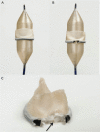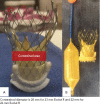Bioprosthetic Aortic Valve Fracture During Valve-in-valve Transcatheter Aortic Valve Implantation
- PMID: 31867060
- PMCID: PMC6918464
- DOI: 10.15420/icr.2019.08.R2
Bioprosthetic Aortic Valve Fracture During Valve-in-valve Transcatheter Aortic Valve Implantation
Abstract
The limited durability of surgical bioprostheses, combined with an ageing population, has led to an increasing demand for replacing degenerated bioprosthetic surgical heart valves, which is projected to increase. Valve-in-valve transcatheter aortic valve implantation involves implanting a transcatheter heart valve within a degenerated bioprosthetic surgical heart valve. A significant minority of patients, however, are left with a suboptimal haemodynamic result with high residual gradients. This is more common with smaller surgical bioprostheses, and may be associated with a worse prognosis. The novel concept of fracturing the previously implanted bioprosthetic surgical heart valve during valve-in-valve transcatheter aortic valve implantation to create a more favourable haemodynamic profile has shown great promise, particularly in smaller valves. Herein, we describe the benefits, limitations and potential complications of this novel approach.
Keywords: Bioprosthetic aortic valve fracture; transcatheter aortic valve implantation; valve-in-valve.
Copyright © 2019, Radcliffe Cardiology.
Conflict of interest statement
Disclosure: CJO has received consultant fees from Edwards Lifesciences. JPO has no conflicts of interest to declare.
Figures



Similar articles
-
Transcatheter aortic valve implantation in failed bioprosthetic surgical valves.JAMA. 2014 Jul;312(2):162-70. doi: 10.1001/jama.2014.7246. JAMA. 2014. PMID: 25005653
-
Optimising the Haemodynamics of Aortic Valve-in-valve Procedures.Interv Cardiol. 2017 May;12(1):40-43. doi: 10.15420/icr.2016:25:2. Interv Cardiol. 2017. PMID: 29588729 Free PMC article.
-
Transcatheter aortic valve-in-valve implantation for patients with degenerative surgical bioprosthetic valves.Circ J. 2015;79(4):695-703. doi: 10.1253/circj.CJ-14-1418. Epub 2015 Mar 20. Circ J. 2015. PMID: 25797021
-
Bioprosthetic aortic valve durability in the era of transcatheter aortic valve implantation.Heart. 2018 Aug;104(16):1323-1332. doi: 10.1136/heartjnl-2017-311582. Epub 2018 May 7. Heart. 2018. PMID: 29735584 Review.
-
Transcatheter Aortic Valve-in-Valve Procedure in Patients with Bioprosthetic Structural Valve Deterioration.Methodist Debakey Cardiovasc J. 2017 Jul-Sep;13(3):132-141. doi: 10.14797/mdcj-13-3-132. Methodist Debakey Cardiovasc J. 2017. PMID: 29743998 Free PMC article. Review.
Cited by
-
Transcatheter Aortic Valve Replacement in Degenerated Perceval Bioprosthesis: Clinical and Technical Aspects in 32 Cases.J Clin Med. 2023 Sep 28;12(19):6265. doi: 10.3390/jcm12196265. J Clin Med. 2023. PMID: 37834910 Free PMC article.
-
High Residual Gradient Following a Self-Expandable Transcatheter Aortic Valve-in-Valve Implantation - Risk Factor Analysis, Outcomes, and Survival.Braz J Cardiovasc Surg. 2022 Oct 8;37(5):710-720. doi: 10.21470/1678-9741-2020-0424. Braz J Cardiovasc Surg. 2022. PMID: 34673507 Free PMC article.
References
-
- Nishimura R, Otto C, Bonow R et al. 2017 AHA/ACC focused update of the 2014 AHA/ACC guideline for the management of patients with valvular heart disease: a report of the American College of Cardiology/American Heart Association Task Force on Clinical Practice Guidelines. J Am Coll Cardiol. 2017;70:252–89. doi: 10.1016/j.jacc.2017.03.011. - DOI - PubMed
-
- Wenaweser P, Buellesfeld L, Gerckens U et al. Percutaneous aortic valve replacement for severe aortic regurgitation in degenerated bioprosthesis: the first valve in valve procedure using the Corevalve revalving system. Catheter Cardiovasc Interv. 2007;70:760–4. doi: 10.1002/ccd.21300. - DOI - PubMed
Publication types
LinkOut - more resources
Full Text Sources
Medical

